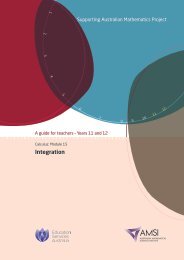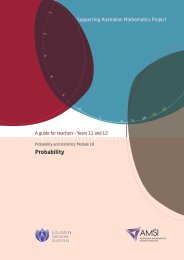PDF Version of module - the Australian Mathematical Sciences ...
PDF Version of module - the Australian Mathematical Sciences ...
PDF Version of module - the Australian Mathematical Sciences ...
Create successful ePaper yourself
Turn your PDF publications into a flip-book with our unique Google optimized e-Paper software.
{14} A guide for teachersSimilarly, we can form <strong>the</strong> set Q[ 2] = {a + b 2:a, b rationals}. This set behaves in manyways like <strong>the</strong> rationals – we can add, subtract, multiply and divide and obtain numbersstill belonging to <strong>the</strong> set. This set contains all <strong>of</strong> <strong>the</strong> rational numbers and is a subset <strong>of</strong><strong>the</strong> real numbers. It is an example <strong>of</strong> a quadratic number field. Sets such as <strong>the</strong>se haveassisted ma<strong>the</strong>maticians in solving all sorts <strong>of</strong> problems in number <strong>the</strong>ory, and motivateideas to many branches <strong>of</strong> modern abstract algebra.HISTORYWe have mentioned in several o<strong>the</strong>r <strong>module</strong>s (see especially <strong>the</strong> <strong>module</strong> on <strong>the</strong> Realnumbers) that <strong>the</strong> Greeks discovered irrational numbers, in <strong>the</strong> form <strong>of</strong> surds, whenapplying Pythagoras’ <strong>the</strong>orem.One <strong>of</strong> <strong>the</strong> best known surds from <strong>the</strong> Greek world is <strong>the</strong> so-called Golden Ratio = 1 + 52 ≈ 1.618034.This number arises geometrically from <strong>the</strong> following problem.A x Ex – 1B1DFCConsider <strong>the</strong> 1 × x rectangle ABCD as shown. The line EF cuts <strong>of</strong>f a 1 × 1 square AEFDas shown. We seek to find <strong>the</strong> value <strong>of</strong> x such that <strong>the</strong> rectangle EBCF is similar to <strong>the</strong>original rectangle ABCD.The Greeks believed that such a rectangle is aes<strong>the</strong>tically pleasing to <strong>the</strong> eye and indeed,<strong>the</strong> base rectangle <strong>of</strong> <strong>the</strong> Par<strong>the</strong>non was built using a rectangle similar to to <strong>the</strong> onedescribed above.Since AEFD is a square, AD = AE = EF = DF = 1, FC = 1 – x. Also, since <strong>the</strong> rectangles aresimilar, ADDC = FCBC and so 1 x = x – 11 . Cross-multiplying and re-arranging, we arrive at <strong>the</strong>quadratic equation which we can solve using <strong>the</strong> quadratic formula to produce,x = 1 + 52 , 1 – 52 . Since x is positive, we take <strong>the</strong> solution x = 1 + 52 . Traditionally thisnumber is given <strong>the</strong> symbol and it is called <strong>the</strong> golden ratio.EXERCISE 8Find <strong>the</strong> value <strong>of</strong> 2 and 1 . Also prove that = 1 + 1 and 3 = 2 + .
















